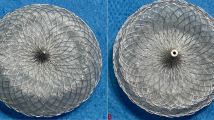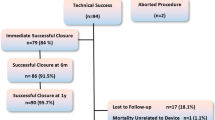Abstract
KONAR-MFO (multifunctional occluder) [Lifetech, Shenzhen, China] was first used in humans in 2013 and received the CE mark in May 2018. As name suggest, it can be use in various(multifunctional) situations in paediatric as well as adults. This is a versatile device with an improved delivery and flexibility which make this device a better option to be use with more comfort and minimum complications. This paper is regarding few rare and complicated lesions, like anomalous origin of coronary artery from pulmonary artery (ALCAPA) device closure, device closure of ventricular septal rupture (VSR) post myocardial infarction in sick elderly and finally device closure of paravalvar leak (PVL)after mitral valve replacement which were treated with this device with excellent results. This study is a retrospective review from a tertiary level dedicated cardiac referral centre in south India. Three cases we are reporting here in which Konar-multifunctional occluders were used in locations other than commoner and regular defects like patent ductus arteriosus, ventricular septal defect etc, over the span of one year between April 2022 and March 2023. Pre-procedure, all patients underwent detailed clinical evaluation followed by transthoracic echocardiography, 12-lead electrocardiogram, and Chest X-ray at the outpatient department. All patients were either symptomatic or had a hemodynamically significant lesion on echocardiography. The decision for transcatheter management was taken after discussing with surgical team in view of either high risk surgery or refusal from patients for surgical options. All patients were followed up post procedure at regular intervals with transthoracic echocardiograms and 12-lead electrocardiograms for a minimum period of 6 months. All these three cases mentioned in our study underwent a complete closure of their respective lesions with no evidence of residual shunt. None of these patients had any major complications, prolonged stay, or any vascular injuries. All patients completed minimum 6-month follow-up and were doing well without any residual flows. First case of ALCAPA, after procedure showed improvement in IVCD, QTc duration and also no significant ischemic changes were noted. Myocardial perfusion scintigraphy was done after 6 months of procedure which showed improvement in contractile function and perfusion of left ventricle. Second case of VSR device closure patient showed immediate significant symptomatic improvement. He was transferred to the coronary care unit, and discharged seven days later. As of now the patient is alive and feeling well with no residual shunt detected by transthoracic echocardiography. No procedure -related complications have been recorded during last two years. Third case of PVL device closure had uneventful recovery from anaesthesia. Prosthetic valve functioned normally during the 5 days of post-procedure hospitalization. The transthoracic 2D- echocardiography performed during follow-up at the end of one month showed no mitral PVL.During follow-up after 1 year, the patient improved symptomatically. Normal prosthetic valve function and no leakage documented on transthoracic echocardiography. Konar-MFO emerging as an important occluder with interesting attributes which makes it a very useful asset to have in catheterizations laboratory.


















Similar content being viewed by others
References
Schubert S, Kelm M, Koneti NR, Berger F (2019) First European experience of percutaneous closure of ventricular septal defects using a new CE-marked VSD occluder. EuroIntervention 15:e242–e243
Vijayalakshmi IB, Narasimhan C, Singh B, Manjunath CN (2017) Treatment of congenital non-ductal shunt lesions with the Amplatzer duct occluder II. Catheter Cardiovasc Interv 89:E185–E193
El-Sisi A, Sobhy R, Jaccoub V et al (2017) Perimembranous ventricular septal defect device closure: choosing between Amplatzer duct occluder I and II. Pediatr Cardiol 38:596–602
Kenny D (2018) Interventional cardiology for congenital heart disease. Korean Circ J 48:350–364
Tanidir IC, Baspinar O, Saygi M, Kervancioglu M, Guzeltas A, Odemis E (2020) Use of LifetechTM Konar-MF, a device for both perimembranous and muscular ventricular septal defects: a multicentre study. Int J Cardiol 310:43–50
Haddad RN, Daou LS, Saliba ZS (2019) Percutaneous closure of restrictive-type perimembranous ventricular septal defect using the new KONAR multifunctional occluder: Midterm outcomes of the first middle-eastern experience. Catheter Cardiovasc Interv. https://doi.org/10.1002/ccd.28678
Egorova AD, Ewert P, Hadamitzky M, Eicken A (2020) Successful percutaneous occlusion of a large left circumflex coronary artery fistula draining into the coronary sinus using a ventricular septal defect occluder: a case report. Eur Heart J Case Rep. https://doi.org/10.1093/ehjcr/ytaa029/5743152
Kreutzer C, Schlichter AJ, Roman MI, Kreutzer GO (2000) Emergency ligation of anomalous left coronary artery arising from the pulmonary artery. Ann Thorac Surg 69(5):1591–1592
Hauser M (2005) Congenital anomalies of the coronary arteries. Heart 91(9):1240–1245
Frapier JM, Leclercq F, Bodino M, Chaptal PA (1999) Malignant ventricular arrhythmias revealing anomalous origin of the left coronary artery from the pulmonary artery in two adults. Eur J Cardiothorac Surg 15(4):539–541
Fierens C, Budts W, Denef B, Van De Werf F (2000) A 72 year old woman with ALCAPA. Heart 83(1):E2
Sathananthan J, Ruygrok P (2013) Evolution in the management of postinfarct ventricular septal defects from surgical to percutaneous approach: a single-center experience. J Invasive Cardiol 25:339–343
Dawson AG, Williams SG, Cole D (2014) Does the placement of an Amplatzer septal occluder device confer benefit in patients with a post-infarction ventricular septal defect? Interact Cardiovasc Thorac Surg 19:1040–1047. https://doi.org/10.1093/icvts/ivu293
Thiele H, Kaulfersch C, Daehnert I, Schoenauer M, Eitel I, Borger M et al (2009) Immediate primary transcatheter closure of postinfarction ventricular septal defects. Eur Heart J 30:81–88. https://doi.org/10.1093/eurheartj/ehn524
Calvert PA, Cockburn J, Wynne D, Ludman P, Rana BS, Northridge D et al (2014) Percutaneous closure of postinfarction ventricular septal defect: in-hospital outcomes and long-term follow-up of UK experience. Circulation 129:2395–2402
Szkutnik M, Bialkowski J, Kusa J, Banaszak P, Baranowski J, Gasior M et al (2003) Postinfarction ventricular septal defect closure with Amplatzer occluders. Eur J Cardiothorac Surg 23:323–327
Demkow M, Ruzyllo W, Kepka C, Chmielak Z, Konka M, Dzielinska Z et al (2005) Primary transcatheter closure of postinfarction ventricular septal defects with the Amplatzer septal occlude—immediate results and up-to 5 years follow-up. Euro Interv 1(43–7):10
Bialkowski J, Szkutnik M, Kusa J, Kalarus Z, Gasior M, Przybylski R et al (2007) Transcatheter closure of postinfarction ventricular septal defects using Amplatzer devices. Rev Esp Cardiol 60:548–551
Holzer R, Balzer D, Amin Z, Ruiz CE, Feinstein J, Bass J et al (2004) Transcatheter closure of postinfarction ventricular septal defects using the new Amplatzer muscular VSD occluder: results of a U.S. Registry. Catheter Cardiovasc Interv 61:196–201. https://doi.org/10.1002/ccd.10784
Matyal R, Wang A, Mahmood F (2013) Percutaneous ventricular septal defect closure with Amplatzer devices resulting in severe tricuspid regurgitation. Catheter Cardiovasc Interv 82:E817–E820. https://doi.org/10.1002/ccd.24803
Perez-David E, Garcia Fernandez MA, García E, de Diego JJG, García Robles JA, Fernandez-Aviles F (2007) Successful transcatheter closure of a postmyocardial infarction ventricular septal rupture in a patient rejected for cardiac surgery: usefulness of transesophageal echocardiography. J Am Soc Echocardiogr 20:1417.e9–12. https://doi.org/10.1016/j.echo.2007.05.01
Werner N, Kilkowski C, Zahn R (2015) Catheter-based closure of paravalvular leaks: “plug the hole.” Herz 40:771–777
Smolka G, Pysz P, Jasinski M et al (2016) Multiplug paravalvular leak closure using Amplatzer Vascular Plugs III: a prospective registry. Catheter Cardiovasc Interv 87:478
Cruz-Gonzalez I, Rama-Merchan JC, Rodríguez-Collado J, Martín-Moreiras J, Diego-Nieto A, Barreiro-Pérez M, Sánchez PL (2017) Transcatheter closure of paravalvular leaks: state of the art. Neth Heart J 25:116–124
Calvert PA, Northbridge DB, Malik IS, Shapiro L, Ludman P, Qureshi SA, Mullen M, Henderson R, Turner M, Been M, Walsh KP, Casserly I, Morrison L, Walker NL, Thomson J, Spence MS, Mahadevan VS, Hoye A, MacCarthy PA, Daniels MJ, Clift P, Davies WR, Adamson PD, Morgan G, Aggarwal SK, Ismail Y, Ormerod JOM, Khan HR, Chandran SS, de Giovanni J, Rana BS, Ormerod O, Hildick-Smith D (2016) Percutaneous device closure of paravalvular leak: combined experience from the United Kingdom and Ireland. Circulation 134:934–944
Acknowledgements
The authors thank Dr Shaad Abqari and Dr. Saurabhi Das for their contributions to the writing of this report.
Author information
Authors and Affiliations
Contributions
MMK-contributed from conception, analysis AG helped in data collection and interpretation of data; or ZSL contributed in pictures AS helped in drafting and software handling in the work; RG drafted the work JM revised it critically PPMM critically analyzed the work.
Corresponding author
Ethics declarations
Conflict of interest
The authors have no competing interest to declare.
Ethical Approval
The study was approved by our local Ethics Committee.
Additional information
Publisher's Note
Springer Nature remains neutral with regard to jurisdictional claims in published maps and institutional affiliations.
Rights and permissions
Springer Nature or its licensor (e.g. a society or other partner) holds exclusive rights to this article under a publishing agreement with the author(s) or other rightsholder(s); author self-archiving of the accepted manuscript version of this article is solely governed by the terms of such publishing agreement and applicable law.
About this article
Cite this article
Kamran, M.M., Gopi, A., Lakhani, Z. et al. Utility of Konar-Multifunctional Occluder in Complex Situations: Unconventional Uses in Rare Situations. Pediatr Cardiol 45, 121–132 (2024). https://doi.org/10.1007/s00246-023-03358-9
Received:
Accepted:
Published:
Issue Date:
DOI: https://doi.org/10.1007/s00246-023-03358-9




